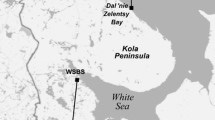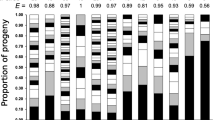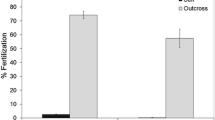Abstract
Biochemical genetic variation provided evidence for the mode of reproduction of brooded young in the sea anemone Epiactis prolifera Verrill, 1869. Individuals of E. prolifera are female when small but hermaphroditic when large (i.e., gynodioecious); juveniles are brooded externally on the column. Brooding individuals collected from 6 intertidal sites (5 in central California and 1 in Washington State, USA) in the spring and summer of 1980 were assayed for gene-enzyme variation by starch-gel electrophoresis. Three of 12 enzyme loci were polymorphic; phosphoglucose isomerase appeared to be encoded by two, closely linked loci. Genotypic frequencies deviated markedly from expected random mating proportions. Only three heterozygotes were found; two were heterozygous at all three polymorphic loci, and the other was polymorphic at the two PGI loci. All 158 juveniles from 25 brooding individuals were assayed (2–19 juveniles per parent). Juveniles on homozygous adults were always identical to their parent. However, brooded young of heterozygous individuals were not identical to their parent. but showed 1:2:1 phenotypic segregation ratios consistent with reproduction by self-fertilization. This genetic evidence together with findings of marked heterozygote deficiencies and genetic identity of homozygous adults and their brooded young supports the conclusion that E. prolifera usually reproduces by self-fertilization, and cross-fertilization is rate.
Similar content being viewed by others
Literature cited
Allard R. W.: Genetic systems associated with colonizing ability in predominantly self-pollinated species. In: The genetics of colonizing species, pp 405–423. Ed. by H. G. Baker and G. L. Stebbins. New York: Academic Press 1965
Allard R. W.: The mating system and microevolution. Genetics, Princeton 79, 115–126 (1975)
Allard, R. W., S. K. Jain and P. L. Workman: The population genetics of inbreeding species. Adv. Genet. 14, 55–131 (1966)
Antonovics, J.: Evolution in closely adjacent plant populations. V. Evolution of self-fertility. Heredity, Lond. 23, 219–238 (1968)
Avise, J. C. and G. B. Kitto: Phosphoglucose isomerase gene duplication in the bony fishes: an evolutionary history. Biochem. Genet. 8, 113–132 (1973)
Ayala, F. J., D. Hedgecock, G. Zumwalt and J. W. Valentine: Genetic variation in Tridacna maxima, an ecological analog of some unsuccessful evolutionary lineages. Evolution, Lawrence, Kansas 27, 177–191 (1973)
Barnes, H. andD. J. Crisp: Evidence of self-fertilization in certain species of barnacles. J. mar. biol. Ass. U.K. 35, 631–639 (1956)
Beckwitt, R.: Electrophoretic evidence for self-fertilization in 2 species of spirorbid polychaetes. Bull. Sth. Calif. Acad. Sci. 81, 61–68 (1982)
Black, R. and M. S. Johnson: Asexual viviparity and population genetics of Actinia tenebrosa. Mar. Biol. 53, 27–31 (1979)
Brown, A. H. D.: Isozymes, plant population structure and genetic conservation. Theor. appl. Genet. 52, 145–157 (1978)
Brown, A. H. D.: Enzyme polymorphism in plant populations. Theor. Popul. Biol. 15, 1–42 (1979)
Bucklin, A. and D. Hedgecock: Biochemical genetic evidence for a third species of Metridium (Coelenterata: Actiniaria). Mar. Biol. 66, 1–7 (1982)
Carlgren, O.: A survey of the Ptychodactiaria, Corallimorpharia and Actiniaria. K. svenska VetenskAkad. Handl. 1, 1–121 (1949)
Carter, M. A. and M. E. Funnell: Reproduction and brooding in Actinia. In: Developmental and cellular biology of coelenterates, pp 17–22. Ed. by P. Tardent and R. Tardent. New York: Elsevier 1980
Carter, M. A. and C. H. Thorp: The reproduction of Actinia equina L. var. mesembryanthenum. J. mar. biol. Ass. U.K. 59, 989–1001 (1979)
Carter, M. A. and J. P. Thorpe: Ecological and genetic evidence that Actinia equina var. mesembryanthemum and var. fragacea are not conspecific. J. mar. biol. Ass. U.K. 61, 79–93 (1981)
Charlesworth, B. and D. Charlesworth: A model for the evolution of dioecy and gynodioecy. Am. Nat. 112, 975–997 (1978)
Chia, F.-S.: Sea anemone reproduction: patterns and adaptive radiations. In: Coelenterate ecology and behavior, pp 261–270. Ed. by G. O. Mackie. New York: Plenum Press 1976
Clark, W. C.: Hermaphroditism as a reproductive strategy for metazoans: some correlated benefits. N. Z. Jl Zool. 5, 769–780 (1978)
Davies, W. E. and N. R. Young: Self-fertility in Trifolium fragiferum. Heredity, Lond. 21, 615–624 (1966)
Dunn, D. F.: The natural history of the sea anemone Epiactis prolifera Verrill 1869 with special reference to its reproductive biology, 187 pp. Ph. D. dissertation, University of California, Berkeley 1972
Dunn, D. F.: Gynodioecy in an animal. Nature, Lond. 253, 528–529 (1975a)
Dunn, D. F.: Reproduction of the externally brooding sea anemone Epiactis prolifera Verrill, 1869. Biol. Bull. mar. biol. Lab., Woods Hole 148, 199–218 (1975b)
Dunn, D. F.: Dynamics of external brooding in the sea anemone Epiactis prolifera. Mar. Biol. 39, 41–49 (1977)
Finnerty, V. and G. Johnson: Post-translational modification as a potential explanation of high levels of enzyme polymorphism: xanthine dehydrogenase and aldehyde oxidase in Drosophila melanogaster. Genetics, Princeton 91, 692–722 (1979)
Gashout, S. E. and R. F. G. Ormond: Evidence for parthenogenetic reproduction in the sea anemone Actinia equina L. J. mar. biol. Ass. U.K. 59, 975–987 (1979)
Ghiselin, M. T.: The evolution of hermaphroditism among animals. Q. Rev. Biol. 44, 189–208 (1969)
Ghiselin, M. T.: The economy of nature and the evolution of sex, 346 pp. Berkeley and Los Angeles: University of California Press 1974
Gottlieb, L. D.: Evidence for duplication and divergence of the structural gene for phosphoglucoisomerase in diploid species of Clarkia. Genetics, Princeton 86, 289–307 (1977)
Gottlieb, L. D. and N. F. Weeden: Gene duplication and phylogeny in Clarkia. Evolution, Lawrence, Kansas 33, 1024–1039 (1979)
Hand, C.: The sea anemones of central California, Part II, The Endomyarian and Mesomyarian anemones. Wasmann J. Biol. 13, 189–251 (1955)
Hedrick, P.: Genetics of populations, 629 pp. Boston: Science Books International 1983
Hoffman, R. J.: Genetics and asexual reproduction of the sea anemone Metridium senile. Biol. Bull. mar. biol. Lab., Woods Hole 151, 478–488 (1976)
Jain, S. K. and R. W. Allard: The effects of linkage, epistasis and inbreeding on population changes under selection. Genetics, Princeton 53, 633–659 (1966)
Larkman, A. U. and M. A. Carter: The spermatozoon of Actinia equina L. var. mesembryanthemum. J. mar. biol. Ass. U.K. 60, 193–204 (1980)
Levene, H.: On a matching problem arising in genetics. Ann. math. Statist. 20, 91–94 (1949)
Lewontin, R. C.: The interaction of selection and linkage. I. General considerations; heterotic models. Genetics, Princeton 49, 49–67 (1964)
Moore, D. M. and H. Lewis: The evolution of self-pollination in Clarkia xantiana. Evolution, Lawrence, Kansas 19, 104–114 (1965)
Orr, J., J. P. Thorpe and M. A. Carter: Biochemical genetic information of the asexual reproduction of brooded offspring in the sea anemone Actinia equina. Mar. Ecol. Prog. Ser. 7, 227–229 (1982)
Ruth, R. C. and F. Wold: The subunit structure of glycolytic enzymes. Comp. Biochem. Physiol. 54B, 1–6 (1976)
Shick, J. M. and A. N. Lamb: Asexual reproduction and genetic population structure in the colonizing sea anemone Haliplanella luciae. Biol. Bull. mar. biol. Lab.,Woods Hole 153, 604–617 (1977)
Sokal, R. R. and F. J. Rohlf: Biometry. The principles and practice of statistics in biological research, 2nd ed. 859 pp. San Francisco: W. H. Freeman & Co. 1981
Stebbins, G. L.: Variation and evolution in plants, 643 pp. New York: Columbia University Press 1950
Tracey, M. L., K. Nelson, D. Hedgecock, R. A. Shleser and M. L. Pressick: Biochemical genetics of lobsters: genetic variation and the structure of American lobster (Homarus americanus) populations. J. Fish. Res. Bd Can. 32, 2091–2101 (1975)
Uchida, T.: A brood-caring actinian subject to a wide range of color variation. J. Fac.Sci. Hokkaido imp. Univ. (VI, Zool.) 3, 17–31 (1934)
Valentine, J. W.: Genetic strategies of adaptation. In: Molecular evolution, pp 78–94. Ed. by F. J. Ayala. Sunderland, Mass.: Sinauer Associates, Inc. 1976
Wright, S.: The interpretation of population structure by F-statistics with special regard to systems of mating. Evolution, Lawrence, Kansas 19, 395–420 (1965)
Wright, S.: Evolution and the genetics of populations. Vol. 2. The theory of gene frequencies, 511 pp. Chicago: University of Chicago Press 1969
Author information
Authors and Affiliations
Additional information
Communicated by N. D. Holland, La Jolla
Rights and permissions
About this article
Cite this article
Bucklin, A., Hedgecock, D. & Hand, C. Genetic evidence of self-fertilization in the sea anemone Epiactis prolifera . Mar. Biol. 84, 175–182 (1984). https://doi.org/10.1007/BF00393002
Accepted:
Issue Date:
DOI: https://doi.org/10.1007/BF00393002




